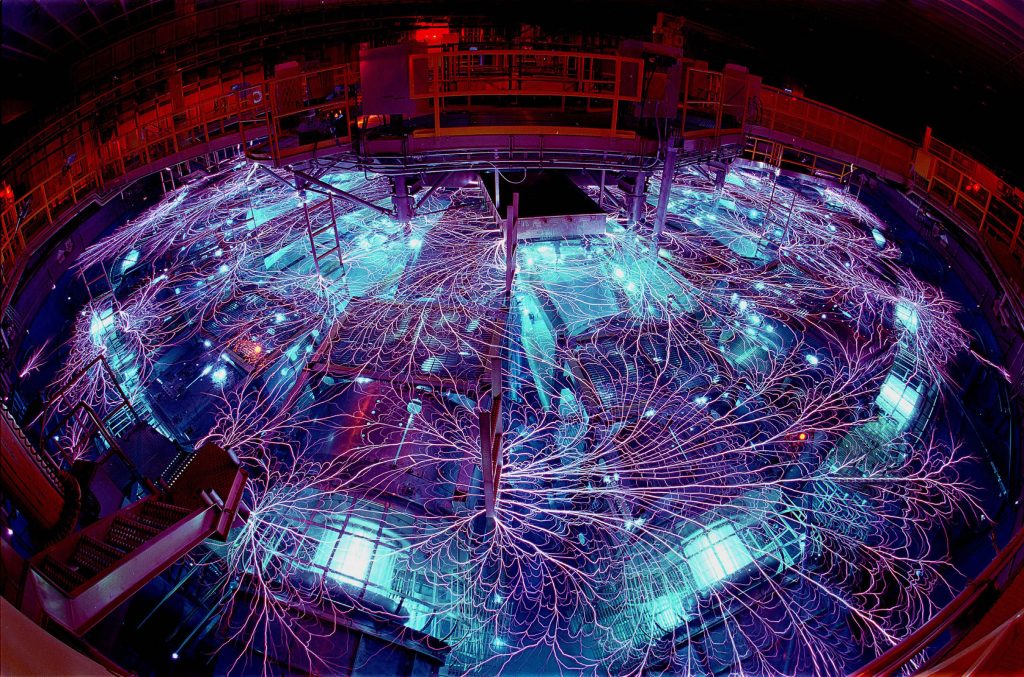
Download 300dpi JPEG image, ‘z-machine.jpg’, 1.3MB (Media are welcome to download/publish this image with related news stories.)
ALBUQUERQUE, N.M. — Sandia National Laboratories’ Z machine, which last year emitted neutrons to enter the race to provide the world virtually unlimited electricity from, essentially, seawater, has received approval from the National Nuclear Security Administration (NNSA) to proceed with a $61.7 million refurbishment. The project is called ZR, for Z-Refurbishment.
The machine’s immediate purpose is to provide data to feed into supercomputers that simulate nuclear weapon explosions and to test materials under extreme conditions.
“The advance will support the weapons program and materials work not only at Sandia but at Livermore and Los Alamos national laboratories,” says Sandia Senior VP Tom Hunter, who managed the funding that made the new installation possible. “This significant upgrade and investment also will allow us to move to a new level of insight of z-pinches and their relationship to fusion. I give credit to the Sandia project team and NNSA for making this a reality.”
Eight years ago, the Z machine startled the world when a technical advance enabled the machine’s power output to rise the way investors want their stock graphs to move: nearly straight up. Output for Sandia’s pulsed power projects, which had increased only slowly for more than a decade, rose dramatically. For Z, just coming on line, an expected usable output of 50 terawatts rose over the next two years to 230 terawatts. This made the machine not only more valuable as a data provider for nuclear weapons simulations but also showed that z-pinches were a possible candidate for peacetime fusion.
Articles noting the advance appeared in newspapers ranging from the New York Times to USA Today, and from Esquire Magazine to Scientific American. The dramatic photo of Z firing became the most widely published picture in Sandia’s history, appearing (among myriad newspapers, magazines, TVs, and textbooks) as the centerfold of a National Geographic issue celebrating “Machines of the Future” and even in a recent issue of the “men’s” magazine Maxim.
Last year, Z researchers announced that Z had generated neutrons by imploding a small capsule filled with deuterium. This emission signaled that the machine not only theoretically but in fact had joined a select group of machines capable of executing high-quality fusion implosion experiments.
The coming upgrade can only increase thermonuclear neutron emission, say Z researchers.
Z’s overall form will be unchanged, but its working numbers will be significantly different.
Instead of 18 million baseline amps bathing the target, 26 million amps will make the journey. The X-ray usable peak emissions will rise from 230 to 350 terawatts (more than 100 times the entire world’s output of electricity for a few nanoseconds.) The [x-ray] energy output will rise from 1.6 to 2.7 megajoules.
In the next two years, 36 new Marx generators (large capacitors) will be installed. Exactly the size of their 20-year-old predecessors, the devices’ newer technology will store twice the energy as the original installation.
Thirty-six very rapid switches, formerly bathed in water and operated en masse by a single signal, will be upgraded to a system — oil-bathed for greater insulation — that alerts each switch individually when to turn on. Each switch controls the electrical current proceeding down 36 transmission lines, each as big around as a horse’s midriff, thus enabling researchers to shape the machine’s electrical pulse. The trigger upgrade and expected improvement in pulse shaping should make the already-overbooked machine even more valuable to researchers from Sandia, LANL, and LLNL whose calculations depend on shape-controlled electrical current flows and X-ray outputs.
Jeff Quintenz, director of Pulsed Power Sciences Center, looks forward to the increase in the facility’s precision. “Now we’re able to produce only the same pulse shape each time, when operating with a particular experimental configuration,” he says. “Without this investment, experimentalists got what we had. Now we can dial a pulse; we have 36 switches that can be timed separately instead of 36 under one control.”
The machine also is expected to be lower-maintenance, with less downtime between shots. Current capacity is 200 shots/year, Quintenz says. The refurbished machine will be capable of 400 shots/year, assuming operational funding is available.
Finally, in terms of capability, Quintenz says, “Z was originally optimized to produce a 50-nanosecond short pulse, with high voltage to accelerate [lithium] ion beams. When we converted to Z, we had to live with a machine designed to drive ion beams. The refurbishment is optimized for high current to suit a z-pinch, not high voltage to drive ions.”
“This is a pretty significant engineering-and-logistics tailoring job,” says Ed Weinbrecht manager of the ZR project. “We have about a year and a half to complete the design and fabricate the parts we need.” Plans then are to dismantle the existing accelerator, move the oil-water separation wall to accommodate the insulation needs of the very fast switches, and install all-new pulse power systems “in what will be a hectic six-month period,” says Weinbrecht.
The overall Z architecture, looked at from the roof, resembles a wagon wheel. Marx generators form the outer rim of the wheel, power transmission lines imitate spokes, and a central vacuum chamber holding the target functions as a kind of axle.
Z-pinches employ high amperages to vaporize tungsten wires thinner than human hairs, creating particles imploding at a million miles an hour (500km/s). These, when colliding, give up their energy in the form of X-rays. Researchers also use the intense magnetic field created by the current either to accelerate particles outward or test the strength of materials.
A less obvious but no less important reason for the new upgrade, says Jeff, is “to exercise our pulsed-power engineering capability so we don’t lose it.” The last big pulsed-power engineering project was for Sandia’s Hermes III facility in 1988, he says.